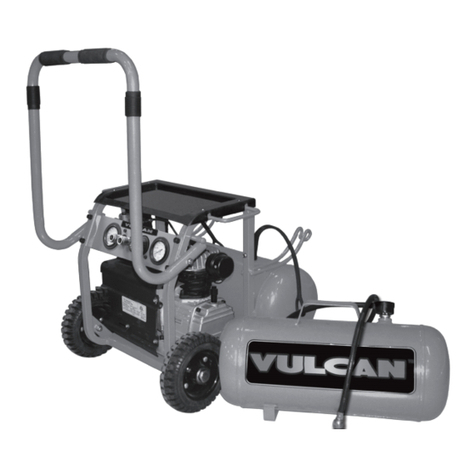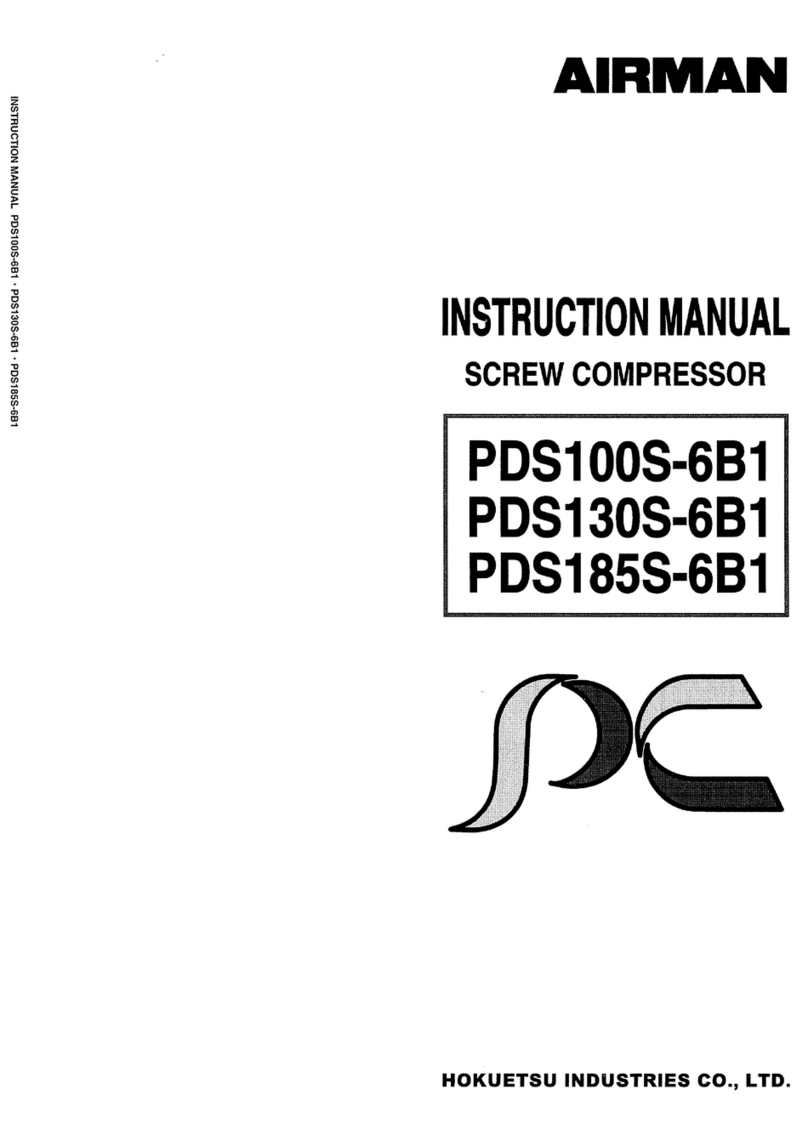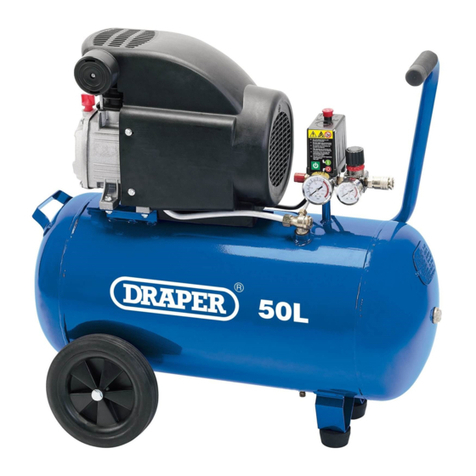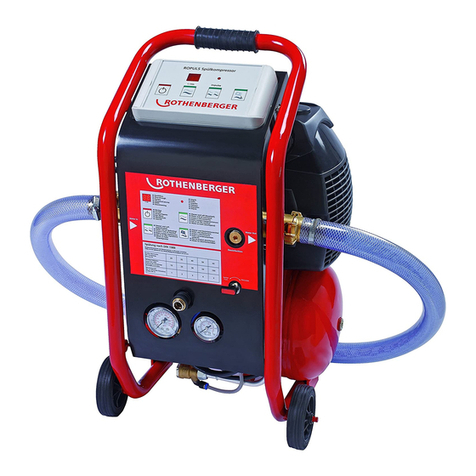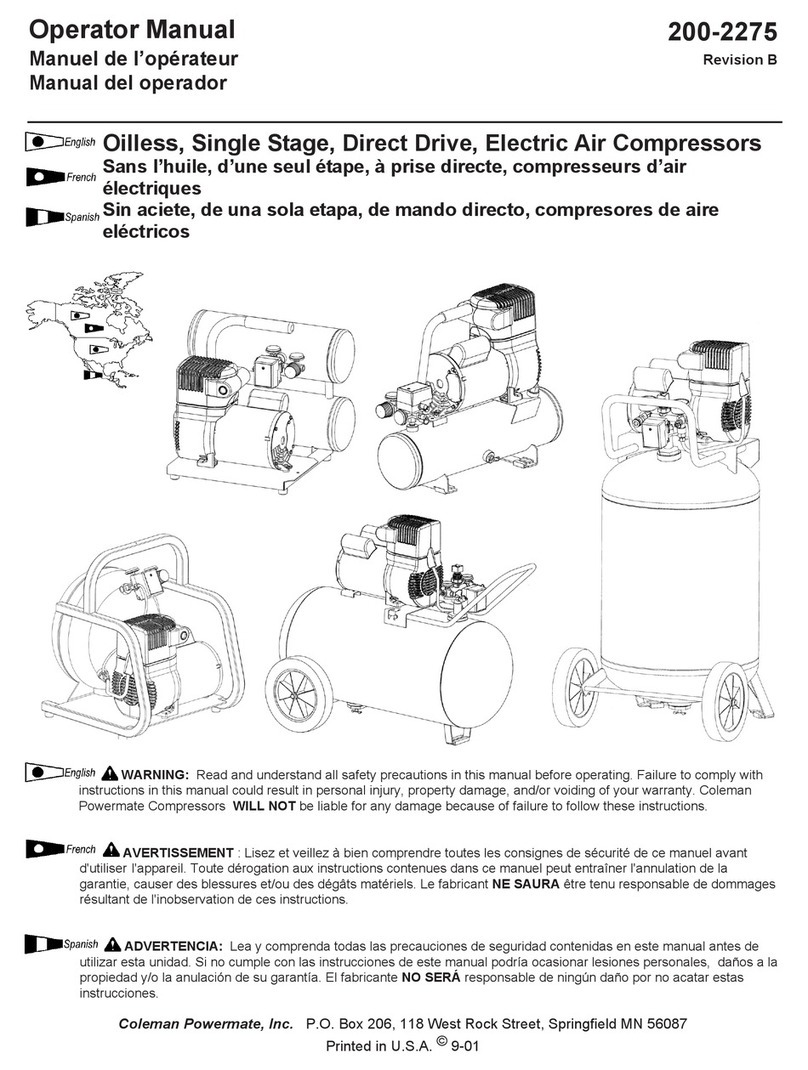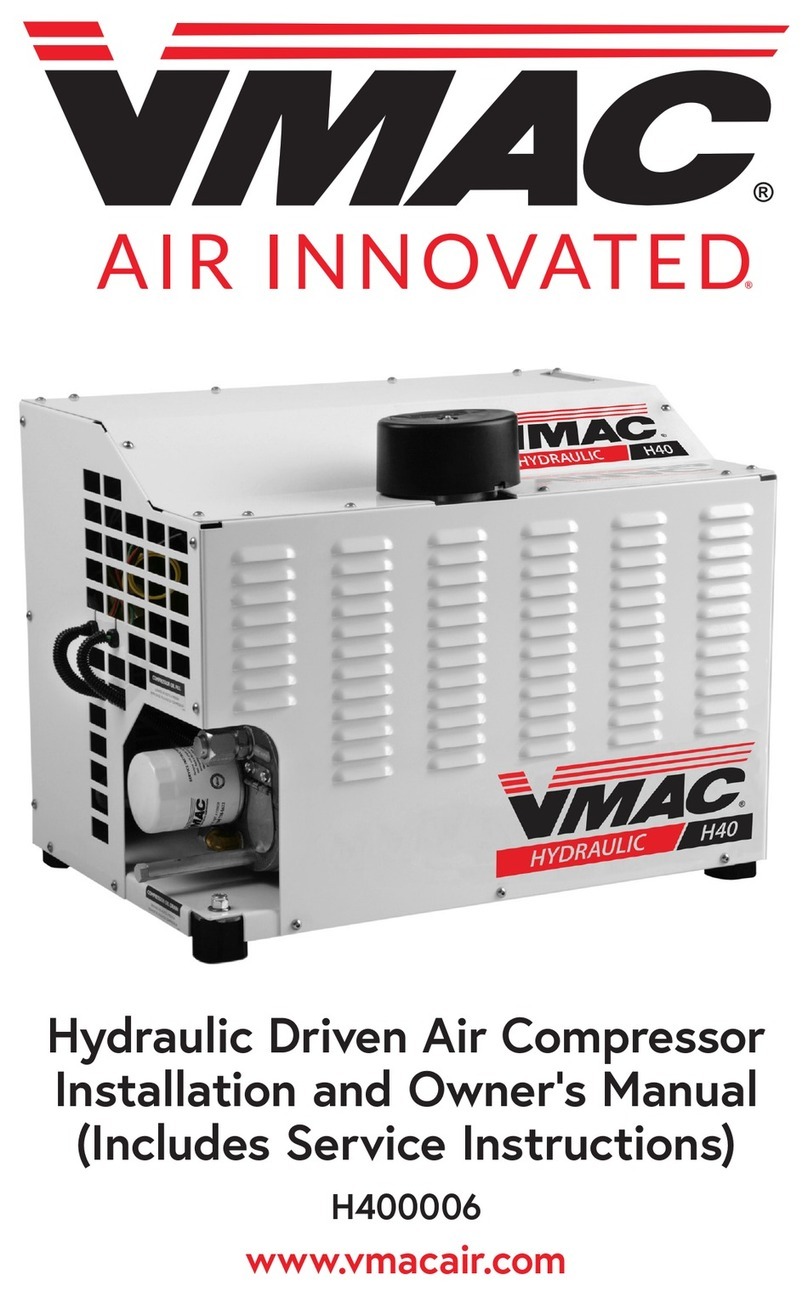Vulcan-Hart 650-4815 User manual

Instruction Manual
Manual de instrucciones
Manuel d’instruction
ITEM NO.
ARTÍCULO NO.
CODE D’ARTICLE
v.090928
28 Gallon Air Compressor
Compressor de aire de 28 galones
Compresseur d’air 28 gallons
650-4815

2
THANK YOU for your purchase of this Vulcan Air Tool. With proper care and use you
can expect your purchase to provide years of trouble free service!
SHOULD YOU HAVE A QUESTION OR A PROBLEM WITH YOUR VULCAN
TOOL, PLEASE CALL OUR CUSTOMER SERVICE DEPARTMENT TOLL FREE AT:
1-800-482-0131
Please have the tool, model number and instruction manual at hand before calling.
ONE YEAR LIMITED CONSUMER WARRANTY
If you have a question or should you have a problem with any Vulcan Air Tool, call the
Vulcan Customer Service line at 1-800-482-0131.
This product is warranted to be free from defects to material and workmanship for a period
of ONE YEAR from date of purchase. If defective the product will be repaired or replaced.
Call the Vulcan Power Tool customer service line at 1-800-482-0131 and a customer
representative will attempt to help resolve any issue. If directed by a representative, return
the product along with proof of purchase to your dealer. Normal wear, damage due to abuse
or mishandling or unauthorized repair is not covered. This warranty does not apply to
accessories. This warranty gives you specic legal rights that vary from state to state.
This tool is intended for consumer use and is not a commercial tool. In the event the tool is
used commercially, the warranty should be for a period of 30 days.
VULCAN AIR TOOLS ARE MADE EXCLUSIVELY FOR:

3
Work Area
Keep work area clean. Cluttered areas invite
injuries.
Consider work area environment. Don’t use
power tools or equipment in damp, wet, or poorly
lit locations. Don’t expose to rain. Keep the
work area well lit. Don’t use in the presence of
ammable gases or liquids.
Keep children and bystanders away. All
children should be kept away from the work
area. Don’t let them handle machines, tools or
extension cords. Visitors can be a distraction and
are difcult to protect from injury.
Electrical Safety
Grounded tools must be plugged into an outlet
that itself is properly installed and grounded.
Grounding provides a low-resistance path to
carry electricity to the ground and away from the
operator, should the tool malfunction electrically.
Do not remove the grounding prong from the
plug or alter the plug in any way. If in doubt as to
whether the outlet is properly grounded according
to code, check with a qualied electrician.
Observe proper precautions regarding double
insulation. This tool is double insulated. It is
equipped with a polarized plug. One blade is
wider than the other, so it will t into a polarized
SAFETY RULES FOR ALL TOOLS
Read and understand all instructions. Failure to follow all instructions listed
below may result in serious personal injury.
SAVE THESE INSTRUCTIONS
When using electric tools, machines or equipment, basic safety precautions should
always be followed to reduce the risk of re, electric shock, and personal injury.
WARNING
!
outlet only one way. If you have difculty
inserting the plug, try reversing it. If it still
doesn’t t, do not alter the plug; have a qualied
electrician install a polarized outlet.
Guard against electric shock. Prevent body
contact with grounded surfaces: pipes, radiators,
ranges, and refrigerator enclosures. When your
body is grounded the risk of electric shock
increases. When working wherever “live”
electrical wires may be encountered, try to
ascertain whether there is a danger of shock.
Even so, DO NOT TOUCH ANY METAL PARTS
OF THE TOOL while using it. Hold the tool only
by the plastic grip to prevent electric shock if you
contact a live wire.
Do not abuse the cord. Never carry your
power equipment by the cord or pull on the cord
to unplug it. Protect the cord from potential
sources of damage: heat, oil & solvents, sharp
edges, or moving parts. Replace damaged cords
immediately.
When working outdoors, use an outdoor-rated
extension cord. An extension cord rated for
outdoor use must be marked “W-A” or “W”.
Do not expose electrical power equipment to
moisture. Rain or wet conditions can cause water
to enter the unit and lead to electric shock.
Recommended Minimum Wire Gauge for Extension Cords
Amps 25’ long 50’ long 75’ long 100’ long 150’ long 200’ long
0 - 5 16 ga. 16 ga. 16 ga. 14 ga. 12 ga. 12 ga.
5.1 - 8 16 ga. 16 ga. 14 ga. 12 ga. 10 ga. Do Not Use
8.1 - 12 14 ga. 14 ga. 12 ga. 10 ga. Do Not Use Do Not Use
12.1 - 15 12 ga. 12 ga. 10 ga. 10 ga. Do Not Use Do Not Use
15.1 - 20 10 ga. 10 ga. 10 ga. Do Not Use Do Not Use Do Not Use
WARNING
!

4
Ensure the extension cord you use is of
sufcient gauge for its length.
Personal Safety
Dress properly. Don’t wear loose clothing or
jewelry; they can be caught in moving parts.
Protective, non-electrically conductive gloves
and non-skid footwear are recommended when
working. Wear protective hair covering to contain
long hair and keep it from harm.
Use eye protection. Use a full-face mask if the
work you’re doing produces metal lings, dust
or wood chips. ANSI Z87.1 compliant, approved
safety glasses with rigid side-shields or goggles
are acceptable in other situations. Wear a clean
dust mask if the work involves creating a lot of
ne or coarse dust.
Don’t overreach. Keep proper footing and
balance at all times. Do not reach over or across
machines that are running.
Stay alert. Watch what you are doing & use
common sense. Don’t operate any tool when you
are tired.
Compressed air cautions: compressed air from
this unit may contain carbon monoxide. The air
produced is neither suitable for breathing nor
food processing without ltering and testing to all
applicable legal standards.
Breathing protection: always use a respirator
when spraying paint or chemicals.
Tool Use and Care
Maintain tools with care. Keep tools sharp and
clean for better and safer performance. Follow
instructions for lubricating and safe performance.
Follow instructions for lubricating and changing
accessories. Keep handles dry, clean and free
from oil and grease.
Avoid unintentional starting. Be sure the
switch is in the off position before plugging in.
Always check and make sure to remove any
adjusting keys or wrenches before turning the
tool on. Left attached, these parts can y off a
rotating part and result in personal injury.
Do not use the tool if it cannot be switched on
or off. Have your tool repaired before using it.
Disconnnect the plug from power before
making any adjustments. Changing attachments
or accessories can be dangerous if the tool could
accidentally start.
Store idle equipment. Store equipment in a dry
area to inhibit rust. Equipment also should be in
a high location or locked up to keep out of reach
of children.
Don’t force the tool. It will do the job better and
more safely at the rate for which it was intended.
Use the right tool. Don’t force a small tool or
attachment to do the work of a larger industrial
tool. Don’t use a tool for a purpose for which it
was not intended.
Secure work. Use clamps or a vise to hold the
work. It’s safer than using your hands and it frees
both hands to operate the tool.
Check for damaged parts. Before using this
tool, any part that is damaged should be carefully
checked to determine that it will operate properly
and perform its intended function. Check for
alignment of moving parts, binding of moving
parts, breakage of parts, mountings, and other
conditions that may affect its operation. Inspect
screws and tighten any ones that are loose. Any
part that is damaged should be properly repaired
or replaced by an authorized service center unless
otherwise indicated elsewhere in the instruction
manual. Have defective switches replaced by an
authorized service center. Don’t use the tool if
switch does not turn it on and off properly.
Never use this equipment if it is leaking air; has
missing or damaged parts, guards, or shields; or
requires repair. Make sure all screws and caps are
securely tightened.
Do not use the air hose to move the compressor.
Release the pressure in the storage tank before
moving.
Maintain tools with care. Keep tools clean for
better and safer performance. Follow instructions
for lubricating and changing accessories. Keep
dry, clean and free from oil and grease.
Do not attempt any maintenance or adjustment
with the compressor in operation, the power
connected, or air under pressure in the system.

5
Service
Check for damaged parts. Make frequent
inspections for the correct function of components
and safety mechanism.
Replacement parts. When servicing, use
only identical replacement parts and fasteners
recommended by us.
Service and repairs should be made by qualied
repair technicians at an authorized repair centre.
Improperly repaired tools could cause serious
shock or injury.
Employers must enforce compliance with the
safety warnings and all other instructions in this
manual. Keep it available for use by everyone
assigned to use this equipment.
Safety precautions for compressor components
Air only: use this compressor for compressing air
only. Do not compress other gases.
Tank safety valve: this valve prevents damage to
the air receiver if a malfunction in the compressor
pump occurs. It is factory pre-set at a limit
specic to your particular model and adjustment.
Do not tamper with it. This will automatically
void your warranty.
Pressure switch: the air pressure switch is factory
pre-set for optimum performance. Do not bypass
or remove this switch. Serious damage to
equipment or personal injury could result from
too high an air pressure.
Motor and compressor pump: air compressors
get hot during operation. Do not touch the
motor, discharge tubing, or compressor while
it is running. The compressor turns itself on
automatically while the power is connected.
Air tanks: over-pressurizing the air receivers,
piping or tanks could cause it to explode or burst.
To protect from over-pressurizing, the compressor
is equipped with a factory preset safety valve. Do
not remove, make adjustments to or substitutions
for this valve. Perform a test of the valve from
time to time: pull the ring on the valve to make
sure that it operates freely. If the valve does not
operate freely, replace it before further use. Never
weld to, drill into, or change the air receivers in
any way.
Tampering: if any of the components above are
found to have been changed or tampered with, the
warranty will be made void. When servicing, we
recommend using only identical replacement parts
and any replacement parts used must have the
same specication as the original equipment.
Smoking. Do not smoke while operating. To
avoid starting a re or setting off an explosion,
never spray where any sparks or ame is present.
The warnings, cautions, and instructions detailed in this manual cannot cover all
possible conditions and situations that occur. It must be understood by the operator
that COMMON SENSE AND CAUTION ARE FACTORS that cannot be built into
this product, but MUST BE SUPPLIED BY THE OPERATOR.
WARNING
!

6
Nomenclature for No. 650-4815 28 gal. Air Compressor

7
Nomenclature for No. 650-4815 28 gal. Air Compressor
KEY
A Rubber foot pads
B Rubber-tired wheel
C 28 gallon (106 L) air tank
D Electrical power cord
E Safety pressure relief valve
F Tank pressure gauge
G Quick-connect air couplers
H Regulator knob
I Regulated output pressure gauge
J Compressor auto-on / off switch
K Air inlet lter / mufer
L Oil ll plug
M Transport handle
N Oil level sight glass
O Crankcase oil drain plug
P Moisture release petcock
SPECIFICATIONS & FEATURES
l28 gallon (106 L) tank
l3 Peak HP
lOil lubricated compressor pump for
durability and long life
lSingle stage, direct drive
lTwo pressure gauges
lLarge 8” (20 cm) rubber tired wheels
lVertical format air tank saves space
lTough powder coated nish
l120 volt, 60 Hz, 15 Amp, single phase
motor
l3400 rpm
l5.3 cfm @ 90 psi, 6.6 cfm @ 40 psi
lMaximum pressure: 150 psi
l50% duty cycle
lASME-approved safety valve
lFinned copper outlet tube
lThermal overload protection ensures safety
and reliability
lWeight: 154.3 lbs (70 kg)
lPackage weight: 161 lbs (73 kg)

8
FUNCTIONAL DESCRIPTION
Your new air compressor can be used for operating paint, weed killer, and insecticide
sprayers, air tools, grease & caulking guns, sandblasters, ination, etc. A tool with a higher air
demand than this compressor can produce may either not function, or not function well. It may
also cause the compressor to run without stopping for long periods of time, trying to maintain
pressure in the tank. This can cause either the motor or compressor pump to overheat and
damage them. Be sure the requirements of your tools can be met by the compressor.
To compress air, the piston in the pump moves up and down in the cylinder. On the down
stroke, air is drawn in through the inlet valve. Since the discharge valve remains closed, as the
piston goes up, the air in the cylinder is compressed. The inlet valve closes and compressed
air is forced out through the discharge valve, through the check valve and into the air receiver.
A check valve prevents it from going back into the pump. Working air is not immediately
available. Air becomes available for use when the receiver pressure is above that required by
the regulator at the air service connection. The pump continues to add air until the air receiver
pressure builds to the factory preset cut-out pressure of the pressure switch.
The air inlet lter openings must be kept clear of obstructions or else it could reduce air
delivery.
SET-UP
After removing it from the carton, and before you can use your compressor,
l check for possible shipping damage to the unit and its components
WARNING
!If you discover any damage, do not operate the compressor until it
is repaired. Failure to do so could result in possible serious injury.
l check for missing parts and components
WARNING
!If any parts are missing, do not operate the compressor until they
have been replaced. Failure to do so could result in possible serious injury.
l add oil preparatory to using your compressor
l retain packing materials until inspection is complete and the compressor runs
satisfactorily
You will need:
l 8 .oz. SAE-20 or SAE-10 non-detergent compressor oil
l small at screwdriver
AIR FILTER INSTALLATION
1. Loosely thread the Air inlet lter / mufer
(K, g.1 & 2) into the hole in the side of the
cylinder head (g.2).
2. To tighten it, use a 24 mm open-end or
combination wrench on the hexagonal
surfaces of the threaded end of the lter,
rather than using your hand on the light
metal housing, which can deform or break
off easily.

9
OIL
WARNING
! This compressor requires oil of
the correct type and quantity to run. Do not
start it without rst following all the steps in
this section.
1. Be sure the compressor is on a level
surface.
2. With the screwdriver, pry off and remove
the shipping plug from the top of the
crankcase
(Q, g.3) revealing the oil ll hole.
3. Through this hole, ll the oil reservoir
with SAE-20 (API CG/CD heavy duty),
non-detergent compressor oil. In extreme
winter conditions, use lighter SAE-10
weight.
4. There may be some oil left over from the
manufacturing process already in the
reservoir.
5. Check the oil level sight glass (N, g.1 &
3). The oil should show level with the red
dot in the centre of the viewing window. Be
careful not to overll.
6. Find the oil ll plug (L in g.1 & 4). It is
usually shipped separately from the
compressor and enclosed with this manual. Be sure there is a rubber O-ring on
the upper part of the threaded end.
7. Put a little pipe thread sealing tape on the threaded end of the oil ll plug.
8. Gently screw the oil breather cap into the oil ll hole. Do not cross-thread or
overtighten.
NOTE Before installing and using this unit, inspect carefully for damage
and corrosion. Make sure the tank, compressor, motor and pump are
undamaged and that all screws and caps are securely tightened.
INSTALLATION AND LOCATION
Locate the compressor in a clean, dry and well-ventilated area; on a rm, level surface. It
should be located 12 to 18 inches from a wall or any other obstruction that would interfere with
the air ow. It is equiped with heat dissipation ns that allow for proper cooling. Keep them and
other parts free of dust or dirt that could interfere with cooling. A clean compressor runs cooler
and provides longer service. Do not place anything on top of the compressor.

10
WARNING
! Do not use lead-tin solder to join pipes and ttings. It can melt at the
temperatures of the compressor’s air discharge and cause the piping to burst.
ELECTRICAL REQUIREMENTS
l Check the specication label and be sure the compressor’s voltage and
amperage requirements match the electrical supply capabilities.
l Plug your compressor into an electrical outlet on dedicated 15 amp household
circuit. The closer the outlet is to the circuit panel, the more reliable the
compressor starting and performance will be. Other devices running on the
same circuit may cause starting problems.
l Ideally, the electrical supply circuit should be protected by a circuit breaker
rather than a fuse. If a fuse is necessary, a dual element time delay fuse should
be used.
EXTENSION CORDS
If you plan to use an extension cord when operating your air compressor, please note:
l Maximum length: not to exceed 50 ft. (15 m)
l Minimum wire size: 14 gauge.
l If the extension cord is too long or the wire size is too small, the air compressor
will not start.
COMPRESSOR LUBRICATION
1. CHECK THE OIL quantity and quality every time before operating the
compressor. Do not add or change oil while the compressor is in operation.
Use only oil with the correct specications
2. With the air compressor on level surface, the oil level should be at the red dot
on the oil level sight glass (N, g.1 & 5).
3. If oil level is low, remove oil ll plug, add enough oil to bring level to the red dot.
Do not over-ll.
4. Replace oil ll plug before starting compressor.

11
DRAINING THE OIL
1. Remove the Crankcase oil drain plug (O, g.1 & 5)). Allow oil to drain
completely.
2. Replace the oil drain plug (we recommend the use of a sealing compound or
teon tape to avoid leakage). Do not over-tighten.
3. Rell with the recommended oil to the red dot in the oil level sight glass
(N, g.1 & 5).
OPERATION
BEFORE OPERATING:
1. Check that all nuts and bolts are all snug.
2. Check the quantity and quality of oil (see compressor lubrication, above).
INITIAL BREAK-IN
1. Open (screw the knurled brass knob in,
counter-clockwise) the Moisture release
petcock (P, g.1 & 6) on the bottom of the
air tank to permit air to escape, so that no
air pressure builds up in the air tank.
2. Plug power supply cord into correct power
source.
3. Pull up on the On/Off switch lever (J, g.1)
to start the compressor.

12
4. Run the compressor in this no-load condition for 15 to 20 minutes to lubricate
the bearings and pistons.
5. Close (turn the knurled knob out, clockwise) the air tank Moisture release
petcock.
6. Pressure will build in the tank and the Pressure switch will stop the pump when
it reaches the pressure set on the regulator. Your compressor is now ready for
use.
NOTE During the break-in period, there may be a slight smell as the
electrical motor brushes seat themselves. This may last for about 5 minutes
and is normal.
CAUTION
! If the compressor does not run properly after 15 minutes of the
break-in or if you notice any abnormalities, please contact the service center.
NOTE If the Pressure switch fails to shut off the compressor for any
reason, the compressor has a safety valve (pictured at E, g.1 & 5) which will
open automaically when pressure in that tank becomes too great.
OPERATION
1. Be sure the On/Off switch (J, g.1) is swung down & in the Off position.
2. Close (turn the knurled knob out, clockwise) the air tank Moisture release
petcock (P, g.1 & 6).
3. Plug in the power cord.
4. Pull up on the On/Off switch to turn the unit on.
5. Adjust the Regulator (H, g.1 & 5) so that the needle on the Regulated output
pressure gauge (I, g.1) is set to the working pressure of the air tool you plan
to use.
6. Connect the air tool to an air hose.
7. Connect the air hose to the compressor by inserting its quick-connector plug
into one of the two quick-connect air couplers (G, g.1 & 5). Be sure the
connectors are properly connected.
8. Follow all instructions for the use of the air tool.
9. As air is used by the tool, the compressor will start up automatically to replenish
the pressure in the tank and stop when full. It will continue to cycle as you work.
WARNING
! The compressor motor and pump can get quite hot in operation. Do
not touch or allow others near the unit during or after operation.
10. When nished, disconnect the air hose by pushing the quick-connect plug in
slightly while sliding the sleeve on the coupler back to release the plug.
11. Swing down the On/Off switch to stop the compressor.
12. Open the moisture release petcock (P, g.1 & 6) on the bottom of the air tank
and allow all the air to escape from the tank.
WARNING
! Wear safety goggles when opening the petcock. The escaping air

13
can raise debris particles which can damage your eyes.
l After 2 weeks, tighten all nuts and bolts, including head bolts.
MAINTENANCE
WARNING
! Before any maintenance or adjustments to your air compressor,
always take the following safety precautions:
1. Disconnect electrical power.
2. Open the petcock to drain air tank of pressure.
DAILY MAINTENANCE
Before each use:
l Check the oil level
l Be sure all nuts and bolts are tight
l Check for any unusual noise or vibration
l After use: open the air tank drain cock to drain condensation from tank. This is
especially critical in cold conditions when condensation could freeze in the tank
and cause mechanical damage as well as rust.
WEEKLY MAINTENANCE
l Clean the air lter by twisting open the metal air lter cap. Remove the lter
element and clean it thoroughly with soap and water.
MONTHLY MAINTENANCE
l Inspect air system for leaks by applying soapy water to all joints.
l Tighten those joints if leakage is observed.
l Check that all nuts and bolts stay tight.
250 HOURS or 6 MONTHS (whichever comes rst): OIL CHANGE
l After 250 hours of use, your compressor will require an oil change.
l Paint spraying operations or dusty environments may require you replace oil
more often
WARNING
! Before removing the oil drain plug or the oil ll cap from your air
compressor, always take the following safety precautions:
l Disconnect electrical power.
l Open the petcock to drain air tank of pressure.
1. Remove the oil drain plug. Allow oil to drain completely.
2. Replace the oil drain plug (we recommend the use of a sealing compound or
tape to avoid leakage). Do not over-tighten.

14
3. Through the oil ll hole, rell the reservoir with SAE-20 or SAE-30 (API CG/CD
heavy duty), non-detergent compressor oil. For extreme winter conditions, use
SAE-10 weight
4. Fill to the red dot in the oil level sight glass. Do not over-ll.
5. Replace the oil ll plug.
CAUTION
!
l All air line components (including hoses, pipe, connectors, lters, & regulators,
etc.) must be rated for a minimum working pressure of 150 psi or 150% of the
maximum system pressure, whichever is greater.
l Disconnect any tools from the air supply before performing maintenance,
clearing a jammed fastener, leaving the work area, moving the tool to another
location, or handing it to another person.
l When cleaning air lter, or any parts in direct contact with the air production, do
not use any ammable or toxic cleaner or solvent.
l During the break-in period, nuts and bolts have a tendency to loosen up. After
two weeks, tighten all nuts and bolts including head bolts.
GENERAL MAINTENANCE
l Keep the vents and cooling vanes clear of dust and debris. This will help
prevent possible electrical shorts and ensure proper cooling.
l Inspect the cord regularly and have it replaced by an authorized repair facility if
it is damaged.
l Check the tanks regularly for dents, cracks, rust, and other damage. Do not use
if any part of the pressurized system is damaged.
l An authorized repair center should do any repairs, modication, or maintenance
that involve disassembling the compressor.
l Please call toll-free 1-800-482-0131 with any questions you have or service
advice you may need.

15
SYMPTOM POSSIBLE CAUSE REMEDY
Compressor runs
continuously Petcock is open Close petcock
Prolonged or excessive use
of air Decrease air demand
Compressor is not large
enough for job Check the air requirement of
air tool.
Restricted check valve Remove and clean, or
replace
Leak in air hose or connector Check and replace if
necessary
Tank leaks Replace tank immediately!
Do not attempt to repair!
Blown seals Replace
Compressor starts and stops
excessively when not in use Petcock is partially open Close petcock
Fittings leak Check ttings with soapy
water. Tighten or re-seal
ttings. Do not over-tighten
Compressor will not start Fuse or circuit breaker tripped Check for cause & replace
or reset
Loose electrical connections Check wiring connections
Extension cord not correct Max. 50 ft. (15 m) min. 14 ga.
Low voltage Consult electrician
Overheated motor Use reset button or wait for
auto reset
Check valve is stuck open Remove and clean or
replace
Pressure bleeder valve on
pressure switch has not
unloaded head pressure
Move switch to Off and then
restart
Paint spray on internal motor
parts Consult service centre
TROUBLESHOOTING
CAUTION
! STOP using the tool immediately if any of the following problems
occur. Serious personal injury could occur. Any repairs or replacements must
be done by a qualied person or an authorized service center only.

16
SYMPTOM POSSIBLE CAUSE REMEDY
Circuit breaker trips (or fuse
blows) too often Low voltage Consult electrician
Excessive wire length Try to run compressor
without extension cord
Restricted air passages Contact service centre
Back pressure in pump head Replace check valve
Replace pressure switch
bleeder valve
Low pressure Air leak in safety relief valve Check valve manually: pull
ring outward
Restricted air lter Clean or replace air lter
Defective check valve Replace check valve
Safety pressure relief valve
opens Defective pressure switch or
improper adjustment Check for proper adjustment
and if problem persists,
replace pressure switch
Oil discharge in air Improper oil viscosity Replace with SAE-20 non-
detergent compressor oil
Too much oil in crankcase Drain crankcase and ll to
correct level
Compressor overheated Air pressure regulated too
high Reduce regulator setting
Restricted air lter Clean and replace air lter
Poor ventilation Relocate compressor
Dirty cooling surface Clean pump cooling vanes
Other Contact technical support
department: 1-800-482-0131
TROUBLESHOOTING
WARNING
!
l Repairs should be made by an authorized repair center.
l Opening this tool could invalidate your warranty.

17
PARTS LIST
Please refer to the Schematic Drawing on page 58.
650-4815 v.090928
NO. DESCRIPTION QTY.
1 Crankcase 1
2 Crank shaft 1
3 Connecting rod 1
4 Bolt M8 1
5 Gasket 1
6 Crank case cover 1
7 Seal ring 1
8 Oil glass 1
9 Bolt M5 6
10 Spring washer Φ5 6
11 Breather 1
12 Circlip 2
13 Piston wrist pin 1
14 Piston 1
15 Oil ring 1
16 Piston ring 2
17 Washer Φ12 1
18 Bolt M12 x 1.75 1
19 Cylinder gasket 1
20 Cylinder 1
21 Pin 2
22 Valve plate 1
23 Valve gasket 1
24 Valve assembly 1
25 Valve plate 1
26 Pressing plate 1
27 Spring washer Φ3 1
28 Bolt M3 1
29 Gasket 1
30 Cylinder head 1
31 Washer Φ8 8
32 Spring washer Φ8 8
33 Bolt M8 4
NO. DESCRIPTION QTY.
34 Elbow 1
35 Air lter 1
36 Outside reset nut 1
37 Outside reset 1
38 Start capacitor 1
39 Capacitor 1
40 Capacitor box 2
41 Spring washer Φ5 8
42 Bolt M5 4
43 Grounding plate 1
44 Washer Φ4 1
45 Bolt M4 1
46 Bolt M5 4
47 Cover 1
48 Bolt M5 2
49 Washer Φ5 2
50 Bolt St4.2 x 8 2
51 Circlip 1
52 Fan 1
53 Spring washer Φ4 1
54 Switch 1
55 Rear bearing crank 1
56 Washer 1
57 Bearing 1
58 Motor shell 1
59 Stator 1
60 Rotor 1
61 Bearing 1
62 Oil seal 1
63 Bolt M8 4
64 Nut M8 4
65 Quick connector 2
66 Pressure switch 1

18
PARTS LIST
Please refer to the Schematic Drawing on page 58.
650-4815 v.090928
NO. DESCRIPTION QTY.
67 Pressure gauge 2
68 End cap 1
69 Regulator supporting frame 1
70 Safety valve 1
71 Unloader tube 1
72 Nut G1/8" 1
73 Small locking ring 1
74 Check valve 1
75 Locking ring 2
76 Nut 2
77 Exhaust pipe 1
78 Handle 1
NO. DESCRIPTION QTY.
79 Bolt M6 4
80 Air tank 1
81 Pin 2
82 Washer Φ8 2
83 Wheel 2
84 Drain cock 1
85 Bolt M8 2
86 Washer Φ8 2
87 Cushion foot 2
88 Nut M8 2
89 Electrical wire 1
90 Plug 1

19
Memphis, TN 38101
GRACIAS por comprar esta herramienta neumática Vulcan. Con un cuidado y uso
apropiado, esta compra le proporcionará muchos años de servicio sin inconvenientes.
SI TIENE DUDAS O PROBLEMAS CON SU HERRAMIENTA VULCAN, LLAME
AL NÚMERO GRATUITO DE NUESTRO DEPARTAMENTO DE SERVICIO AL
CLIENTE:
1-800-482-0131
Asegúrese de tener la herramienta, el número de modelo y el manual de
instrucciones a mano antes de llamar.
GARANTÍA LIMITADA AL CONSUMIDOR POR UN AÑO
Si tiene dudas o problemas con cualquier herramienta neumática Vulcan, llame a la línea de
servicio al cliente de Vulcan al 1-800-482-0131.
Se garantiza que este producto no presentará fallas de materiales ni fabricación durante un
período de UN AÑO a partir de la fecha de compra. Si presentara alguna falla, el producto
será reparado o reemplazado. Llame a la línea de servicio al cliente de herramientas
eléctricas Vulcan, 1-800-482-0131, y un representante de servicio intentará ayudarlo a
resolver cualquier inconveniente. Si el representante se lo indica, devuelva el producto a su
distribuidor junto con el comprobante de compra. Esta garantía no cubre el desgaste normal,
los daños debidos al abuso, el uso inapropiado o las reparaciones no autorizadas. Esta
garantía no cubre los accesorios. A través de esta garantía usted cuenta con derechos legales
especícos que varían de estado a estado.
Esta herramienta está diseñada para uso particular y no se trata de una herramienta
comercial. En caso de que esta herramienta se use con nes comerciales, la garantía se
limitará a un período de 30 días.
LAS HERRAMIENTAS NEUMÁTICAS VULCAN SON FABRICADAS
EXCLUSIVAMENTE PARA:

20
Área de trabajo
Mantenga el área de trabajo limpia. Las áreas
desordenadas propician las lesiones.
Considere el ambiente del área de trabajo.
No use herramientas o equipo eléctrico en
ubicaciones mojadas, húmedas o con poca
iluminación. No lo exponga a la lluvia. Mantenga
el área de trabajo bien iluminada. No la use en
presencia de gases inamables o líquidos.
Mantenga alejados a los niños y transeúntes.
Todos los niños deben mantenerse apartados
del área de trabajo. No permita que manipulen
máquinas, herramientas ni cables de extensión.
Los visitantes pueden ser una distracción y es
difícil protegerlos de lesiones.
Seguridad eléctrica
Las herramientas puestas a tierra deben ser
conectadas en un tomacorriente que esté instalado
apropiadamente y que tenga puesta a tierra.
La puesta a tierra proporciona una ruta de baja
resistencia para conducir electricidad a la tierra y
lejos del operador, en caso de que la herramienta
presente un mal funcionamiento eléctrico. No
elimine la espiga de puesta a tierra del conector ni
lo altere de ninguna forma. En caso de duda sobre
si el tomacorriente tiene puesta a tierra de acuerdo
a lo establecido, consulte con un electricista
calicado.
Observe precauciones relacionadas con el
doble aislamiento. Esta herramienta cuenta con
doble aislamiento. Está equipada con un conector
polarizado. Una espiga es más ancha que la otra,
para que se adapte al tomacorriente polarizado de
una sola manera. Si tiene dicultad para insertar
DISPOSICIONES DE SEGURIDAD PARA TODAS LAS
HERRAMIENTAS
Lea y comprenda todas las instrucciones. El incumplimiento de las
instrucciones presentadas a continuación podría resultar en daño personal
grave.
CONSERVE ESTAS INSTRUCCIONES
Al utilizar herramientas eléctricas, máquias o equpos, siempre debe seguir
las precauciones de seguridad básicas para reducir el riesgo de incendio,
choque eléctrico y lesiones personales.
el conector, pruebe de la manera contraria. Si
todavía no se inserta, no altere el conector;
haga que un electricista calicado instale un
tomacorriente polarizado.
Protección contra choque eléctrico. Evite el
contacto del cuerpo con supercies puesta a tierra:
tuberías, radiadores, cocinas y refrigeradores.
Cuando su cuerpo hace contacto a tierra, el riesgo
de choque eléctrico aumenta. Al trabajar en
cualquier lucar donde pueda encontrar alambres
eléctricos “con energía”, trate de asegurarse
si existe un peligro de choque. Aún así, NO
TOQUE NINGUNA PARTE METÁLICA DE
LA HERRAMIENTA al usarla. Sostenga la
herramienta sólo del mango plástico para evitar
el choque eléctrico de entrar en contacto con un
alambre con energía.
No maltrate el cable. Nunca transporte su equipo
eléctrico arrastrándolo desde el cable o tirando de
él para desconectarlo. Proteja el cable de fuentes
de daño potencial: calor, aceite y solventes,
bordes alados o partes movibles. Reemplace los
cables dañados de inmediato.
Al trabajar en exteriores, use un cable de
extensión aprobado para tal n. Un cable de
extensión aprobado para uso en exteriores debe
tener marcado “w-a” o “w”.
No exponga el equipo eléctrico a la humedad.
La lluvia o las condiciones húmedas pueden
causar el ingreso de agua a la unidad y provocar
el choque eléctrico.
ADVERTENCIA
!
ADVERTENCIA
!
Table of contents
Languages:
Other Vulcan-Hart Air Compressor manuals
Popular Air Compressor manuals by other brands

Hitachi
Hitachi NEXT Series instruction manual

Porter-Cable
Porter-Cable 888970-799 instruction manual
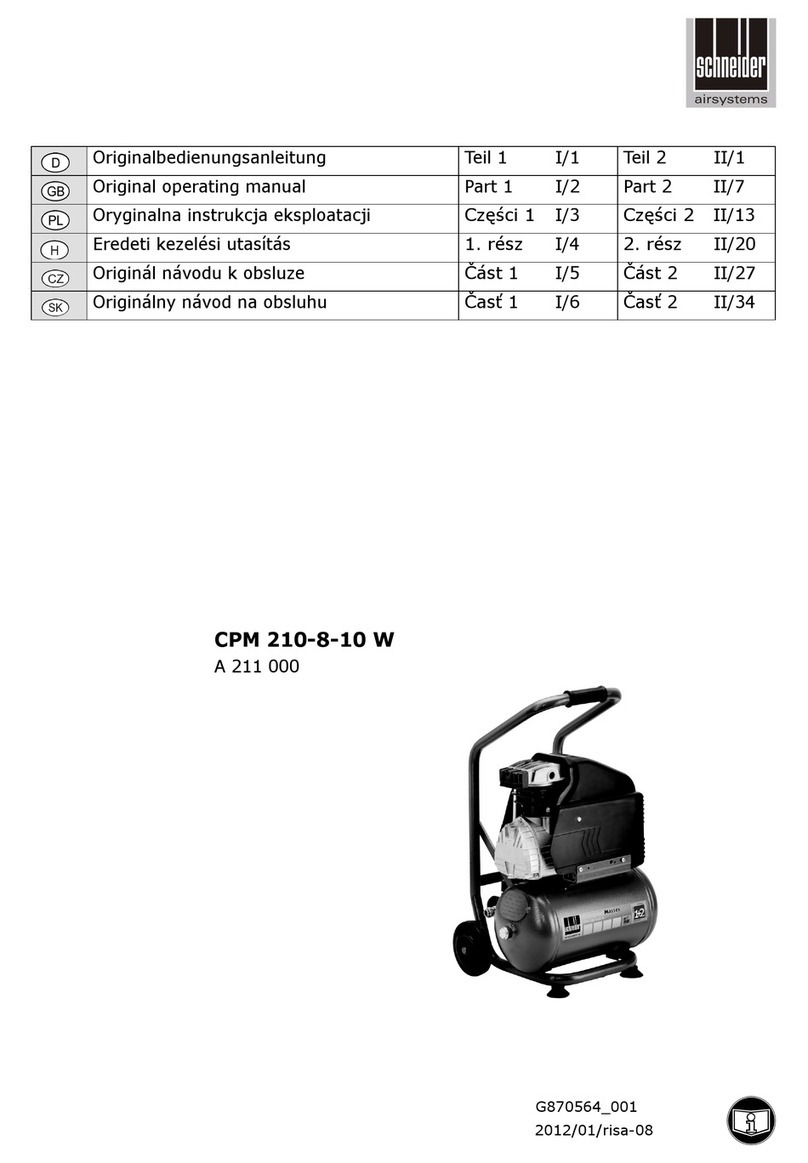
Schneider Airsystems
Schneider Airsystems CPM 210-8-10 W Original operating manual
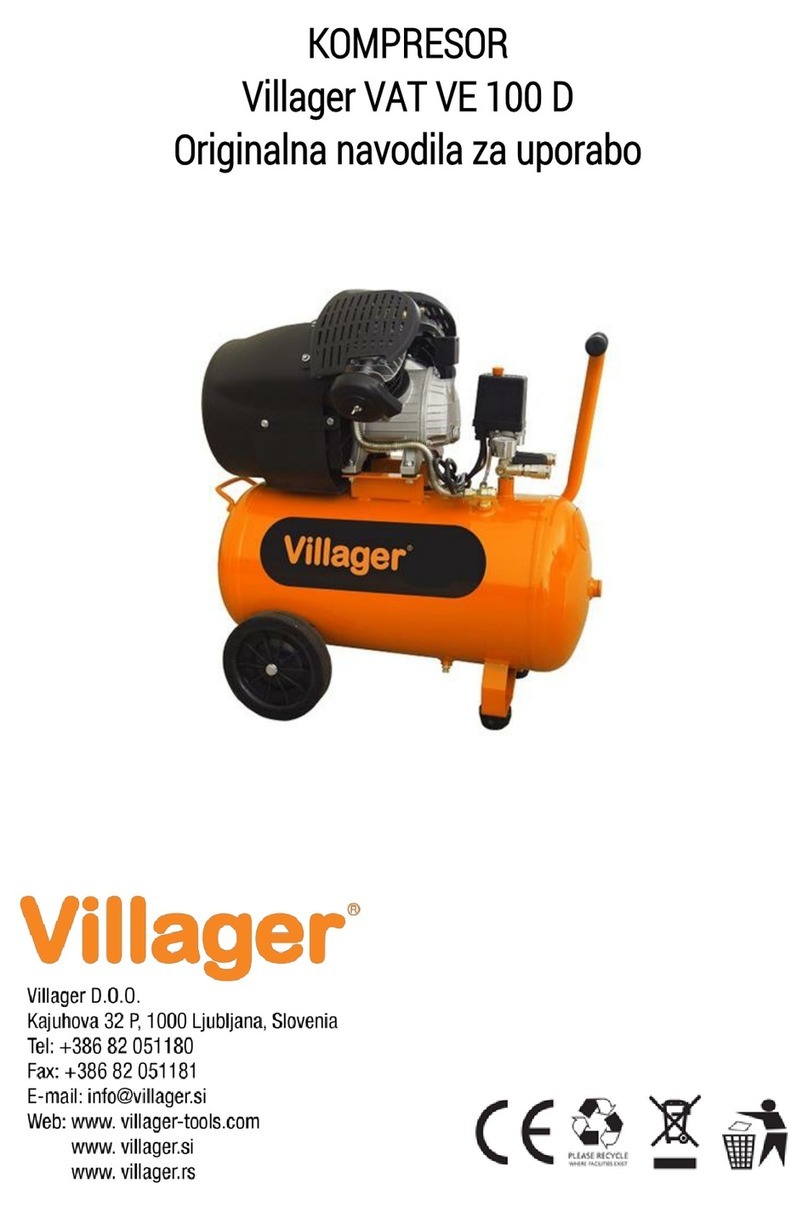
Villager
Villager VAT VE 100 D manual

Sakura
Sakura Dry-Boy SDB-45 Installer's & owner's manual
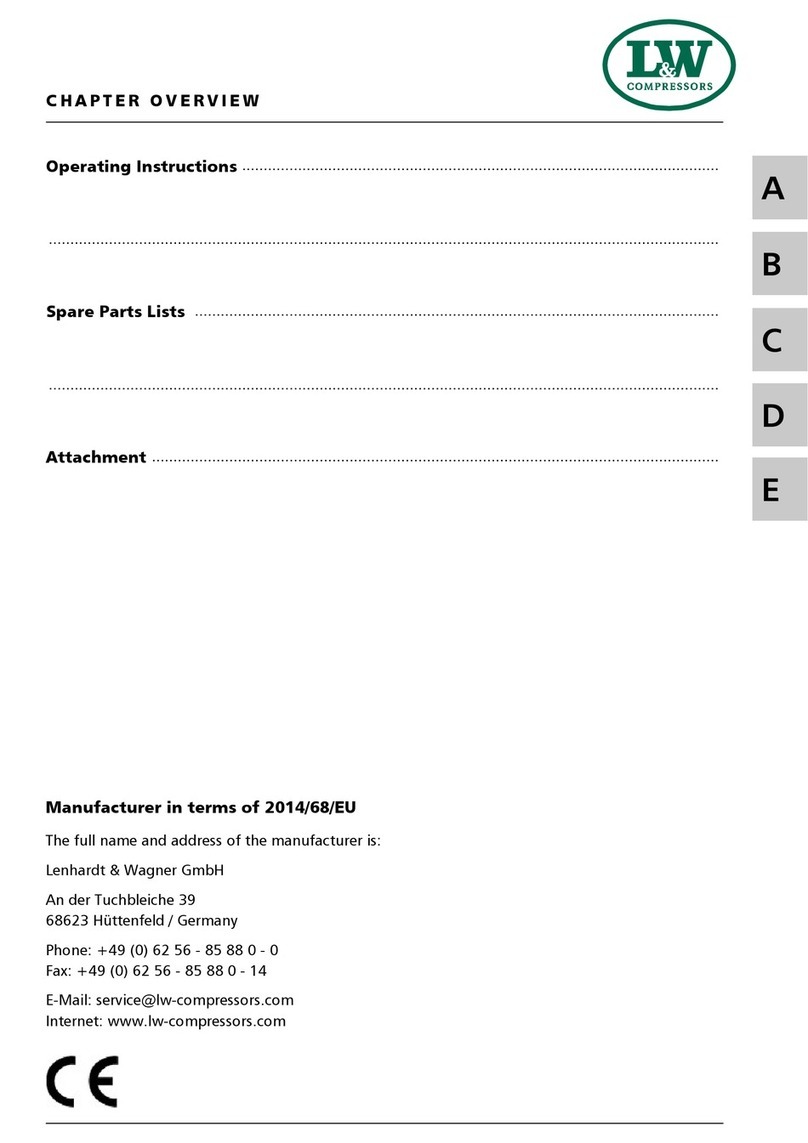
L&W
L&W SC-600 ES operating instructions
